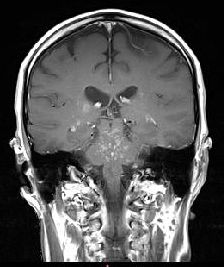 |
| The greenest caterpillar I ever saw! |
... or rather, I call on a neurologist.
Last week was my first (and likely only) appointment this year with my neurologist who has been managing my care since I was diagnosed in 2011. Since I last saw him my drug regime changed slightly due to some worries about blood tests. My understanding was that my total white cell count was dropping too low which would make me susceptible to infection.
My neurologist clarified this by explaining that there are several different types of cells in the total. The one which was causing concern in my case was the neutrophil count. The web tells me that neutrophils fight infection and if there are too few of them even bacteria normally found in the mouth, on the skin and in the stomach can cause serious problems. Now the drug (Azathioprine) I take for CLIPPERS aims to reduce the lymphocyte count - lymphocytes are the cells associated with CLIPPERS. But clearly for whatever reason, both cell counts were being driven down over the summer. He was reassured by my more recent test results and my Azathioprine dose is high enough (based on body weight) to still be having an effect on lymphocytes. We did the usual eye-tracking and finger-pointing tests and some checks on muscle-tone and reflexes and nothing cropped up there.
We also had a discussion about long term Azathioprine use. Unfortunately we don't know for sure if that is what is keeping me well. I said that if the risks of serious illness associated with taking Azathioprine long-term were low then I felt I had more to lose if I stopped taking it and suffered a CLIPPERS relapse. He said he agreed but it was hard to be definitive because of the lack of knowledge about how CLIPPERS works. So I said I would keep taking the tablets.
It is also sobering when reminded that my status is "in remission from cerebellar disease" which sounds like I am stuck in some kind of waiting room.
Read other articles in this series at Living With CLIPPERS.
Living With CLIPPERS by Bill Crum is licensed under a Creative Commons Attribution-NonCommercial-NoDerivs 3.0 Unported License.














